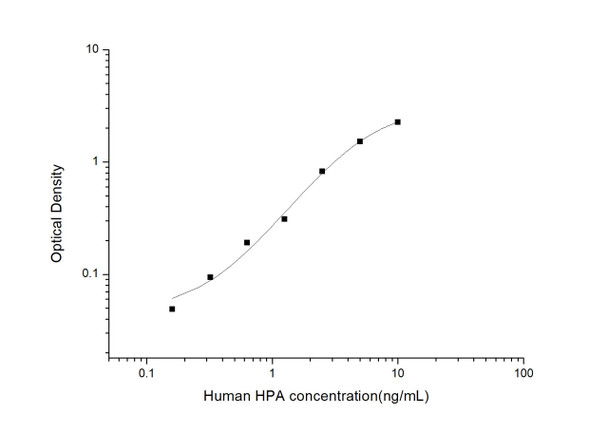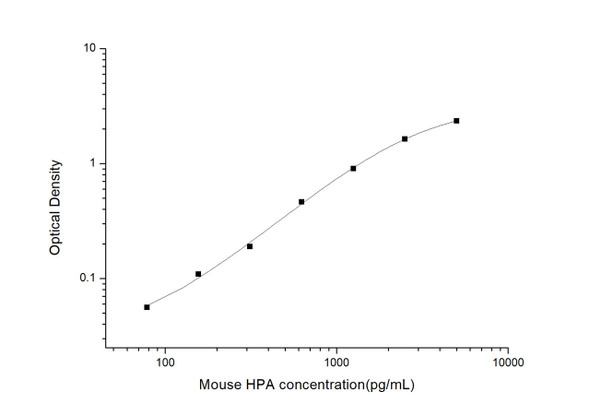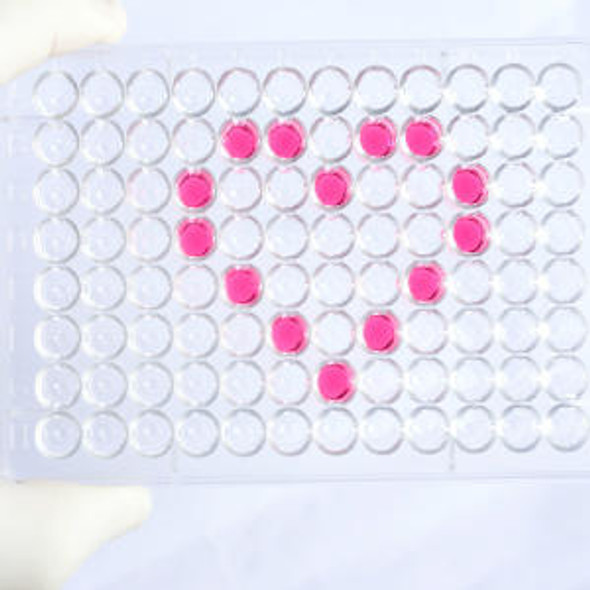Human Cell Biology ELISA Kits 1
Human HPA (Heparanase) ELISA Kit (HUES03236)
- SKU:
- HUES03236
- Product Type:
- ELISA Kit
- Size:
- 96 Assays
- Uniprot:
- Q9Y251
- Sensitivity:
- 0.09ng/mL
- Range:
- 0.16-10ng/mL
- ELISA Type:
- Sandwich
- Synonyms:
- HPSE, HPR1, HPSE1, HSE1
- Reactivity:
- Human
- Sample Type:
- Serum, plasma and other biological fluids
- Research Area:
- Cell Biology
Description
| Assay type: | Sandwich |
| Format: | 96T |
| Assay time: | 4.5h |
| Reactivity: | Human |
| Detection Method: | Colormetric |
| Detection Range: | 0.16-10 ng/mL |
| Sensitivity: | 0.10 ng/mL |
| Sample Volume Required Per Well: | 100µL |
| Sample Type: | Serum, plasma and other biological fluids |
| Specificity: | This kit recognizes Human HPA in samples. No significant cross-reactivity or interference between Human HPA and analogues was observed. |
This ELISA kit uses Sandwich-ELISA as the method. The micro ELISA plate provided in this kit has been pre-coated with an antibody specific to Human HPA. Standards or samples are added to the appropriate micro ELISA plate wells and combined with the specific antibody. Then a biotinylated detection antibody specific for Human HPA and Avidin-Horseradish Peroxidase (HRP) conjugate are added to each micro plate well successively and incubated. Free components are washed away. The substrate solution is added to each well. Only those wells that contain Human HPA, biotinylated detection antibody and Avidin-HRP conjugate will appear blue in color. The enzyme-substrate reaction is terminated by adding Stop Solution and the color turns yellow. The optical density (OD) is measured spectrophotometrically at a wavelength of 450 nm ± 2 nm. The OD value is proportional to the concentration of Human HPA. The concentration of Human HPA in samples can be calculated by comparing the OD of the samples to the standard curve.
| UniProt Protein Function: | HPSE: Endoglycosidase that cleaves heparan sulfate proteoglycans (HSPGs) into heparan sulfate side chains and core proteoglycans. Participates in extracellular matrix (ECM) degradation and remodeling. Selectively cleaves the linkage between a glucuronic acid unit and an N-sulfo glucosamine unit carrying either a 3-O-sulfo or a 6-O-sulfo group. Can also cleave the linkage between a glucuronic acid unit and an N-sulfo glucosamine unit carrying a 2-O-sulfo group, but not linkages between a glucuronic acid unit and a 2-O-sulfated iduronic acid moiety. It is essentially inactive at neutral pH but becomes active under acidic conditions such as during tumor invasion and in inflammatory processes. Facilitates cell migration associated with metastasis, wound healing and inflammation. Enhances shedding of syndecans, and increases endothelial invasion and angiogenesis in myelomas. Acts as procoagulant by increasing the generation of activation factor X in the presence of tissue factor and activation factor VII. Increases cell adhesion to the extacellular matrix (ECM), independent of its enzymatic activity. Induces AKT1/PKB phosphorylation via lipid rafts increasing cell mobility and invasion. Heparin increases this AKT1/PKB activation. Regulates osteogenesis. Enhances angiogenesis through up- regulation of SRC-mediated activation of VEGF. Implicated in hair follicle inner root sheath differentiation and hair homeostasis. Belongs to the glycosyl hydrolase 79 family. |
| UniProt Protein Details: | Protein type:EC 3. 2. 1. 166; Glycan Metabolism - glycosaminoglycan degradation; Hydrolase; Extracellular matrix; Secreted, signal peptide; Secreted Chromosomal Location of Human Ortholog: 4q21. 3 Cellular Component: nucleoplasm; lysosomal lumen; intracellular membrane-bound organelle; lysosomal membrane; lysosome; extracellular region; nucleus; lipid raft Molecular Function:protein dimerization activity; syndecan binding; protein binding; beta-glucuronidase activity; heparanase activity Biological Process: positive regulation of hair follicle development; proteoglycan metabolic process; positive regulation of protein kinase B signaling cascade; glycosaminoglycan catabolic process; heparan sulfate proteoglycan catabolic process; positive regulation of blood coagulation; glycosaminoglycan metabolic process; cell-matrix adhesion; positive regulation of osteoblast proliferation; carbohydrate metabolic process; pathogenesis; regulation of hair follicle development |
| NCBI Summary: | Heparan sulfate proteoglycans are major components of the basement membrane and extracellular matrix. The protein encoded by this gene is an enzyme that cleaves heparan sulfate proteoglycans to permit cell movement through remodeling of the extracellular matrix. In addition, this cleavage can release bioactive molecules from the extracellular matrix. Several transcript variants encoding different isoforms have been found for this gene. [provided by RefSeq, Sep 2011] |
| UniProt Code: | Q9Y251 |
| NCBI GenInfo Identifier: | 296434532 |
| NCBI Gene ID: | 10855 |
| NCBI Accession: | Q9Y251. 2 |
| UniProt Secondary Accession: | Q9Y251,Q53GE5, Q9UL39, A9JIG7, C7F7I3, C7F7I4, E9PCA9 E9PGR1, |
| UniProt Related Accession: | Q9Y251 |
| Molecular Weight: | 42,791 Da |
| NCBI Full Name: | Heparanase |
| NCBI Synonym Full Names: | heparanase |
| NCBI Official Symbol: | HPSE |
| NCBI Official Synonym Symbols: | HPA; HPA1; HPR1; HSE1; HPSE1 |
| NCBI Protein Information: | heparanase; endo-glucoronidase; heparanase-1 |
| UniProt Protein Name: | Heparanase |
| UniProt Synonym Protein Names: | Endo-glucoronidase; Heparanase-1; Hpa1 |
| Protein Family: | HpaII very short patch repair endonuclease |
| UniProt Gene Name: | HPSE |
| UniProt Entry Name: | HPSE_HUMAN |
As the OD values of the standard curve may vary according to the conditions of the actual assay performance (e. g. operator, pipetting technique, washing technique or temperature effects), the operator should establish a standard curve for each test. Typical standard curve and data is provided below for reference only.
| Concentration (ng/mL) | O.D | Average | Corrected |
| 10 | 2.3 2.346 | 2.323 | 2.269 |
| 5 | 1.543 1.599 | 1.571 | 1.517 |
| 2.5 | 0.884 0.872 | 0.878 | 0.824 |
| 1.25 | 0.361 0.369 | 0.365 | 0.311 |
| 0.63 | 0.256 0.234 | 0.245 | 0.191 |
| 0.32 | 0.156 0.14 | 0.148 | 0.094 |
| 0.16 | 0.097 0.109 | 0.103 | 0.049 |
| 0 | 0.05 0.058 | 0.054 | -- |
Precision
Intra-assay Precision (Precision within an assay): 3 samples with low, mid range and high level Human HPA were tested 20 times on one plate, respectively.
Inter-assay Precision (Precision between assays): 3 samples with low, mid range and high level Human HPA were tested on 3 different plates, 20 replicates in each plate.
| Intra-assay Precision | Inter-assay Precision | |||||
| Sample | 1 | 2 | 3 | 1 | 2 | 3 |
| n | 20 | 20 | 20 | 20 | 20 | 20 |
| Mean (ng/mL) | 0.54 | 1.09 | 4.17 | 0.53 | 1.15 | 4.57 |
| Standard deviation | 0.04 | 0.05 | 0.13 | 0.04 | 0.05 | 0.19 |
| C V (%) | 7.41 | 4.59 | 3.12 | 7.55 | 4.35 | 4.16 |
Recovery
The recovery of Human HPA spiked at three different levels in samples throughout the range of the assay was evaluated in various matrices.
| Sample Type | Range (%) | Average Recovery (%) |
| Serum (n=5) | 93-104 | 98 |
| EDTA plasma (n=5) | 87-102 | 94 |
| Cell culture media (n=5) | 92-106 | 98 |
Linearity
Samples were spiked with high concentrations of Human HPA and diluted with Reference Standard & Sample Diluent to produce samples with values within the range of the assay.
| Serum (n=5) | EDTA plasma (n=5) | Cell culture media (n=5) | ||
| 1:2 | Range (%) | 89-103 | 100-116 | 94-108 |
| Average (%) | 96 | 106 | 101 | |
| 1:4 | Range (%) | 93-105 | 84-98 | 85-97 |
| Average (%) | 98 | 91 | 91 | |
| 1:8 | Range (%) | 85-100 | 80-92 | 85-99 |
| Average (%) | 92 | 86 | 90 | |
| 1:16 | Range (%) | 85-99 | 84-96 | 88-98 |
| Average (%) | 92 | 90 | 93 |
An unopened kit can be stored at 4°C for 1 month. If the kit is not used within 1 month, store the items separately according to the following conditions once the kit is received.
| Item | Specifications | Storage |
| Micro ELISA Plate(Dismountable) | 8 wells ×12 strips | -20°C, 6 months |
| Reference Standard | 2 vials | |
| Concentrated Biotinylated Detection Ab (100×) | 1 vial, 120 µL | |
| Concentrated HRP Conjugate (100×) | 1 vial, 120 µL | -20°C(shading light), 6 months |
| Reference Standard & Sample Diluent | 1 vial, 20 mL | 4°C, 6 months |
| Biotinylated Detection Ab Diluent | 1 vial, 14 mL | |
| HRP Conjugate Diluent | 1 vial, 14 mL | |
| Concentrated Wash Buffer (25×) | 1 vial, 30 mL | |
| Substrate Reagent | 1 vial, 10 mL | 4°C(shading light) |
| Stop Solution | 1 vial, 10 mL | 4°C |
| Plate Sealer | 5 pieces | |
| Product Description | 1 copy | |
| Certificate of Analysis | 1 copy |
- Set standard, test sample and control (zero) wells on the pre-coated plate and record theirpositions. It is recommended to measure each standard and sample in duplicate. Note: addall solutions to the bottom of the plate wells while avoiding contact with the well walls. Ensuresolutions do not foam when adding to the wells.
- Aliquot 100µl of standard solutions into the standard wells.
- Add 100µl of Sample / Standard dilution buffer into the control (zero) well.
- Add 100µl of properly diluted sample (serum, plasma, tissue homogenates and otherbiological fluids) into test sample wells.
- Cover the plate with the sealer provided in the kit and incubate for 90 min at 37°C.
- Aspirate the liquid from each well, do not wash. Immediately add 100µL of BiotinylatedDetection Ab working solution to each well. Cover the plate with a plate seal and gently mix. Incubate for 1 hour at 37°C.
- Aspirate or decant the solution from the plate and add 350µL of wash buffer to each welland incubate for 1-2 minutes at room temperature. Aspirate the solution from each well andclap the plate on absorbent filter paper to dry. Repeat this process 3 times. Note: a microplatewasher can be used in this step and other wash steps.
- Add 100µL of HRP Conjugate working solution to each well. Cover with a plate seal andincubate for 30 min at 37°C.
- Aspirate or decant the solution from each well. Repeat the wash process for five times asconducted in step 7.
- Add 90µL of Substrate Reagent to each well. Cover with a new plate seal and incubate forapproximately 15 min at 37°C. Protect the plate from light. Note: the reaction time can beshortened or extended according to the actual color change, but not by more than 30min.
- Add 50 µL of Stop Solution to each well. Note: Adding the stop solution should be done inthe same order as the substrate solution.
- Determine the optical density (OD value) of each well immediately with a microplate readerset at 450 nm.






